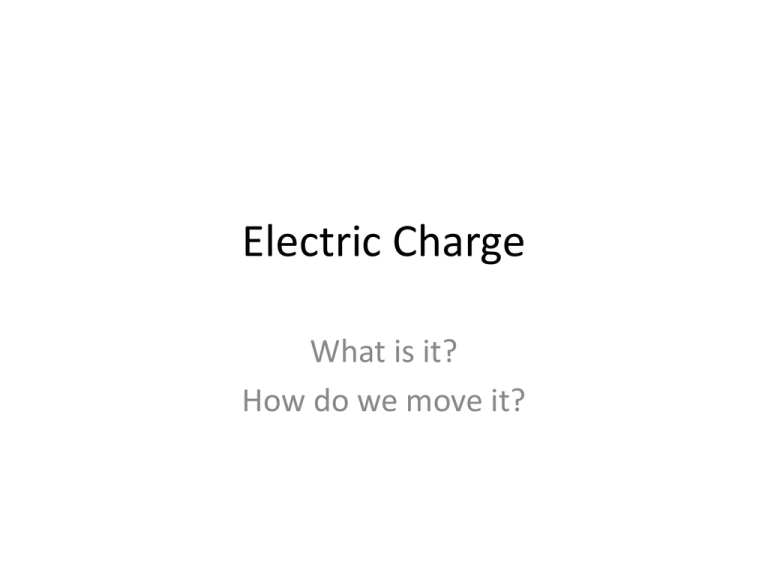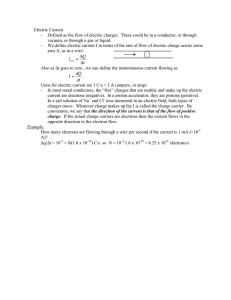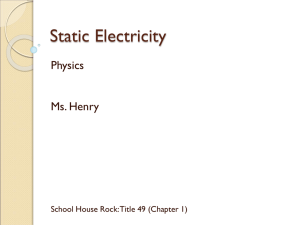Electric Charge
advertisement

Electric Charge What is it? How do we move it? Comparison of Subatomic Particles Relative Particle Symbol Charge Mass Electron e- -1 Proton p+ +1 1 Neutron n0 0 1 Charge is Quantized • There is a minimum amount of charge that can exist (1 electron) • All charges are an integer multiple of this charge Millikan’s Oil Drop Experiment • Electron charge = – 1.60 10-19 C • Proton charge = + 1.60 10-19 C Charge is Conserved • Due to its dependence on matter (electrons & protons), charge must be conserved • The total amount will be the same at the end as it was at the start • When electrons are transferred, the value of charge created is equal Charged Objects • An object becomes charged when it has an imbalance of subatomic particles. • More e- than p+ = negative charge • More p+ than e- = positive charge Effects of Unbalanced Charges • Objects that have an imbalance of protons and electrons will experience a change in motion – Like charges repel – Opposite charges attract Properties of objects determines the behaviors of excess charge • Conductors • Electric charges move freely within a framework of protons • Most metals are conductors • When any part of the conductor gains an excess charge, that charge is distributed throughout the entire object Properties of objects determines the behaviors of excess charge • Insulators • Electrons do not travel freely between atoms • Atoms that acquire an excess charge will maintain that charge; it will not be distributed throughout the entire object Charging • Interaction between objects will result in an imbalance of protons and neutrons • Electrons are transferred between objects – The object that gains electrons will have a negative charge – The object that loses electrons will have a positive charge • The direction of electron transfer depends on the materials involved Charging by Friction - + - + - + - + - + - + Charging by Conduction • Electrons are transferred by contact • When objects that have different affinity for electrons come into contact, electrons are transferred • Conductors and insulators can both be charged by conduction, but what happens to the excess charge depends on whether the object is a conductor or insultor Grounding • Electrons are transferred to or from the Earth by contact • The Earth can accept or donate an infinite number of electrons without gaining a charge, due to the incredible number of atoms in the Earth Induction • In certain cases, conductors can allow charges to move within the conductor without actually gaining an imbalance of positive or negative charge • The nature of conductors is responsible for this ability Induction • The charged object will repel the like charges in the conductors • Conductors have the ability to transfer charge easily Induction Forces Between Charges • Electric charge can cause changes in motion, which means that they exert force – Like charges repel – Opposite charges attract Coulomb’s Law • • q1 & q2 = value of two charges • d = distance between charges • kC = 8.99 109 (Coulomb Constant) Coulomb’s Law • • The force is directly related to the sizes of the charges • The force is inversely related to the distance between the charges squared Field Forces & Field Theory • Certain forces (gravity, electric charge, magnetism) have the ability to affect objects in the space around them even though they do not actually touch these objects • Field theory was proposed by Michael Faraday to explain “action at a distance” (field forces) – He actually proposed it for electric fields, but it applies to other types of field forces as well • The area around the object where it can affect other objects is called the “force field” Electric Field • What happens to a positive charge around the charge(s) in question? Electric Field • The lines move away from positive charges and towards negative charges




